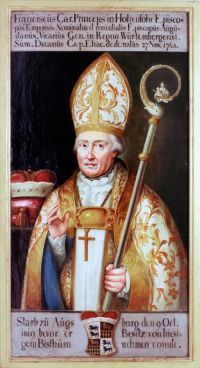Franz Karl Joseph zu Hohenlohe-Waldenburg-Schillingsfürst
Franz Karl Joseph Xaver Prince of Hohenlohe-Waldenburg-Schillingsfürst (born November 27, 1745 in Waldenburg , † October 9, 1819 in Augsburg ) was auxiliary bishop and bishop of Augsburg and vicar general of Neuwuerttemberg .
Live and act
Franz Karl Joseph came from the Hohenlohe family . He was the son of Prince Karl Albrecht I zu Hohenlohe-Waldenburg-Schillingsfürst (* September 22, 1719 - January 25, 1793) and his first wife Sophie Wilhelmine zu Löwenstein-Wertheim-Rochefort (* August 7, 1721; † 29 September 1749).
He was raised by Jesuits , studied in Parma and Strasbourg and was ordained a priest on April 7, 1787 in Cologne . He later acted as dean of the prince provost of Ellwangen , and also as cathedral chapter in Cologne , Vienna and Strasbourg. Under Clemens Wenzeslaus of Saxony , the last prince-bishop of Augsburg, Hohenlohe advanced to his auxiliary bishop on August 9, 1802, shortly before the prince-bishopric was secularized . At the same time he received the dignity of Titular Bishop of Tempe . The consecration was given to him on September 5th by his prince-bishop in the parish church of Marktoberdorf , with the assistance of the abbots of Irsee and Füssen .
After the secularization, the prince-bishopric of Augsburg existed in the spiritual realm, initially within its old borders.
In autumn 1812, after the death of Bishop Clemens Wenzeslaus of Saxony, a vicariate general was created under the direction of Auxiliary Bishop Hohenlohe for the parts of the duchy of Augsburg that had fallen to Württemberg in Ellwangen . The initial plan of Elector Friedrich failed to create a Wurttemberg diocese of Ellwangen from the Vicariate General; The General Vicariate founded by the state lacked ecclesiastical confirmation anyway. Hohenlohe represented it as administrator at the Württemberg meetings of the estates from 1815 to 1817. The priest Joseph Mets (1758–1819), a friend of Johann Michael Sailer , who, unlike Hohenlohe, had excellent administrative skills, acted as his closest collaborator and confidante . Between 1813 and 1817 the auxiliary bishop resided exclusively in Ellwangen and during this time did not come to Augsburg or the now Bavarian part of the diocese to carry out pontifical acts there. In a letter dated March 21, 1816, Pope Pius VII confirmed the establishment of the General Vicariate in Ellwangen and declared the ecclesiastical acts carried out there by Bishop Hohenlohe to be valid. The vicar general was Johann Baptist von Keller , later, the first bishop of Rottenburg, given as Pro-Vicar to the side and the Generalvikariat moved his seat in the fall of 1817 to Rottenburg am Neckar ; In 1821 the Württemberg diocese Rottenburg was created .
A vicariate general was created in 1812 for the parts of the old prince-bishopric of Augsburg that fell to Bavaria , under the direction of Canon Franz Friedrich von Sturmfeder ; he resided in Augsburg. Hohenlohe-Waldenburg-Schillingsfürst retired there in May 1817 and resumed his functions as auxiliary bishop of Augsburg, while he left the management of the business in Ellwangen and Rottenburg to the provicer.
On February 5, 1818, Hohenlohe-Waldenburg-Schillingsfürst was appointed bishop of the now purely Bavarian diocese of Augsburg, which had resurrected within the new borders; however, he died on October 9, 1819. From then on, Sturmfeder , now as vicar capitular , led the diocese until the successor Joseph Maria von Fraunberg took office in 1821. Hohenlohe-Waldenburg-Schillingsfürst was buried in the Augsburg cathedral at the entrance to the east choir.
The bishop's nephew was Alexander zu Hohenlohe-Waldenburg-Schillingsfürst , titular bishop of Sardika . He had stayed with his uncle in Ellwangen from 1814 to 1815 as a theology student. Johann Michael Sailer , who later became Bishop of Regensburg, gave him the primary sermon there in 1815 .
literature
- Frank Raberg : Biographical handbook of the Württemberg state parliament members 1815-1933 . On behalf of the Commission for Historical Regional Studies in Baden-Württemberg. Kohlhammer, Stuttgart 2001, ISBN 3-17-016604-2 , p. 388 .
- Friedrich Lauchert : Hohenlohe-Waldenburg, Franz Prince to . In: Allgemeine Deutsche Biographie (ADB). Volume 50, Duncker & Humblot, Leipzig 1905, p. 441 f.
- Franz Xaver von Funk : The Catholic State University of Ellwangen and its relocation to Tübingen. In: Festgabe on the twenty-five year anniversary of his majesty the reign of King Karl von Württemberg. Revered by the University of Tübingen. Laupp, Tübingen 1889, separate count p. 1–30, here p. 6–27 (also special print).
- Ignaz von Longner: Contributions to the history of the Upper Rhine church province. Laupp, Tübingen 1863, pp. 362-394 .
- Stephan Jakob Neher (Ed.): Statistical Personal Catalog of the Diocese of Rottenburg. Festschrift for the 50th anniversary of this diocese. Schmid, Schwäbisch Gmünd 1878, p. 7.
See also
Web links
Individual evidence
- ↑ Genealogical page on parents and siblings
- ↑ On Joseph Mets ( Memento from June 29, 2007 in the Internet Archive )
- ↑ On Sailer's nephew and lingering in Ellwangen: Franz Heinrich Reusch: Hohenlohe-Waldenburg-Schillingsfürst, Prince Alexander . In: Allgemeine Deutsche Biographie (ADB). Volume 12, Duncker & Humblot, Leipzig 1880, p. 683 f.
| predecessor | Office | successor |
|---|---|---|
| Franz Friedrich von Sturmfeder |
Bishop of Augsburg 1818 -1819 |
Joseph Maria von Fraunberg |
| personal data | |
|---|---|
| SURNAME | Hohenlohe-Waldenburg-Schillingsfürst, Franz Karl Joseph to |
| ALTERNATIVE NAMES | Hohenlohe-Waldenburg-Schillingsfürst, Franz Joseph Xaver Karl Fürst zu (full name) |
| BRIEF DESCRIPTION | Auxiliary Bishop and Bishop of Augsburg |
| DATE OF BIRTH | November 27, 1745 |
| PLACE OF BIRTH | Waldenburg |
| DATE OF DEATH | October 9, 1819 |
| Place of death | augsburg |


